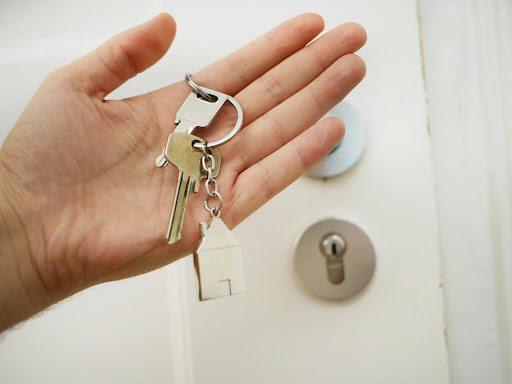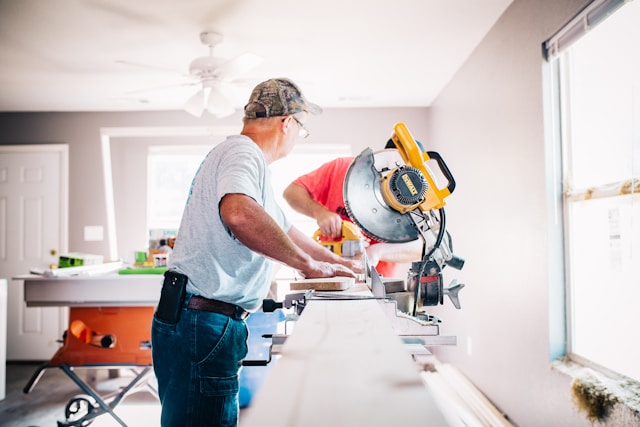
Dreaming of a bathroom that looks like it belongs in a luxury hotel or spa? Remodeling your existing bathroom offers the perfect chance to transform this private oasis into a space for relaxation and rejuvenation.
Though bathroom remodels require significant planning, design work, and physical labor, the payoff can be really rewarding. Not only will you wind up with a gorgeous new bathroom that meets your functional needs, but bath remodels also provide one of the highest returns on investment for homeowners.
Read the complete guide to bathroom remodels and see how the process works from beginning to end.
Create a Layout Plan
One of the first steps in a bathroom remodel is laying out where key elements will go, such as the toilet, sink/vanity, shower/tub, and storage. Consider bumping out walls, removing and building new walls, or borrowing space from adjacent areas if needed to fit desired fixtures. Pay attention to plumbing lines and electrical when altering floor plans.
You’ll also want to think about traffic flow, making sure there is enough clearance around doors, fixtures, and the toilet. Having a strong layout plan before finalizing design details or purchasing materials will help avoid potentially costly changes later. Use graph paper or home design software to map concepts.
Set Your Budget
Before beginning any remodeling project, it’s critical to determine your budget. Understanding the average bathroom remodeling cost in your area can provide an excellent reference to calculate your spending.
Bathroom remodels can range significantly in price depending on the size of the space, materials used, whether you do updates vs. a complete renovation and various other factors. As a general rule of thumb, minor cosmetic updates may cost a few thousand dollars, while a major redesign of a master bathroom involving layout changes may cost tens of thousands.
When setting your budget, be sure to include not just materials and labor, but also permits, design fees if using a professional, contingency for unexpected issues, and fixtures/appliances. Get multiple quotes and understand what is included before committing to a number.
Setting realistic expectations for what you can afford will help guide decision-making.
Choose Fixtures and Finishes
The fixtures, finishes, and materials you select will bring your design vision to life while meeting functional needs. For sinks, choose between options like a pedestal, vessel, undermount, and integrated. Pick faucets and handles that match the sink style (widespread, center set, single-handle, etc.)
For showers, decide between types like walk-in, neo-angled, and curbless. Select tile, natural stone, solid surface, or other waterproof materials. Choose lighting, hardware, mirrors, vanities/cabinetry, toilets, and accessories in finishes that coordinate. Create a cohesive look.
Improve Ventilation and Lighting
Proper ventilation and lighting should be part of any bathroom remodel. Moisture buildup can lead to mold/mildew, damage surfaces, and cause unpleasant odors. Exhaust fans help whisk away humidity. Choose ENERGY STAR models that work with humidity sensors or timers.
If no windows are present, skylights or solar tubes can let natural light in. Add fixtures like recessed lighting around the vanity and shower for tasks and accent lighting for style. Building code requires GFCI electrical outlets within 3 feet of sinks. Ensure adequate circuits to handle the added load.
Incorporate Storage
In the bathroom, you can never have too much storage. Evaluate what you currently have vs. what you need. For towels and toiletries, add more cabinets, drawers, shelving, and organizers. Use every inch, including wall space and under sinks. If ripping out and replacing cabinets, look for options with enhanced storage systems featuring pull-out trays, angled corners, and slide-out bins.
A medicine cabinet can also add function. For toilet paper rolls, cleaning items, backstock, and hampers, consider freestanding storage furniture. Don’t forget the often forgotten areas like stairs or eaves.
Upgrade for Accessibility/Aging in Place
As we age, mobility and physical abilities change. Even if not needed immediately, consider accessible updates that allow “aging in place,” so your remodel serves long-term needs. Grab bars, curbless showers, comfort height toilets, and seats are helpful additions.
Replace knobs with easy-to-grip lever handles. Contrasting colors between walls and floors helps those with poor eyesight. Install non-slip shower/tub flooring. Ensure adequate lighting and electrical outlets. By planning, you can avoid much more expensive renovations down the road.
Choose Water Efficient Plumbing
Water efficiency should be top of mind for any bathroom remodel. Toilets account for nearly 30% of an average home’s indoor water use. Replace outdated models using over 3 gallons per flush (GPF) with WaterSense toilets using 1.28 GPF or less.
For faucets and showerheads, WaterSense-labeled models use at least 20% less water than standard 2.2 GPM models without sacrificing performance. Install instant water heaters for efficiency. Insulate pipes to reduce heat loss. Investing in water conservation plumbing can lead to significant utility bill savings over time.
Prepare for Remodeling Work
Once project plans are finalized, you’ll need to prepare the bathroom for the renovation process. First, remove all accessories and belongings so they aren’t damaged. Protect existing elements like windows, trim, and flooring with drop cloths. Turn off the power to the room at the breaker.
Seal doorways with plastic sheeting to prevent dust from spreading. Set up temporary lighting. Rent a dumpster for efficient debris removal. Install temp facilities like a toilet if the bathroom will be out of commission.
Alert household members about work schedules and access limitations. Proper prep makes the project smoother.
Stay Within Budget During Remodel
During the renovation process, it’s not uncommon for unexpected issues to arise that can impact project scope and budget. Hidden water damage is a common bathroom remodel surprise. Manage the budget carefully to allow room for contingencies without overspending. Get multiple quotes if additional work arises.
Research and price shop materials using websites and apps before making purchases. Look for closeout and overstock items. Set a threshold for change orders requiring sign-off before proceeding.
Keep lines of communication open with the contractor. Careful monitoring and decisive change management keep budgets intact.
Conclusion
Remodeling a tired, outdated bathroom can feel overwhelming but also liberating. Following essential tips like setting a realistic budget, designing an efficient layout, closely monitoring the renovation process, and actively maintaining the finished bathroom will help ensure success.
Leverage the expertise of reputable local contractors and designers. With careful attention to critical details throughout your bathroom remodeling journey, you’ll be rewarded with a safe, functional space that meets your family’s needs and design tastes for years to come – all within your budget.



